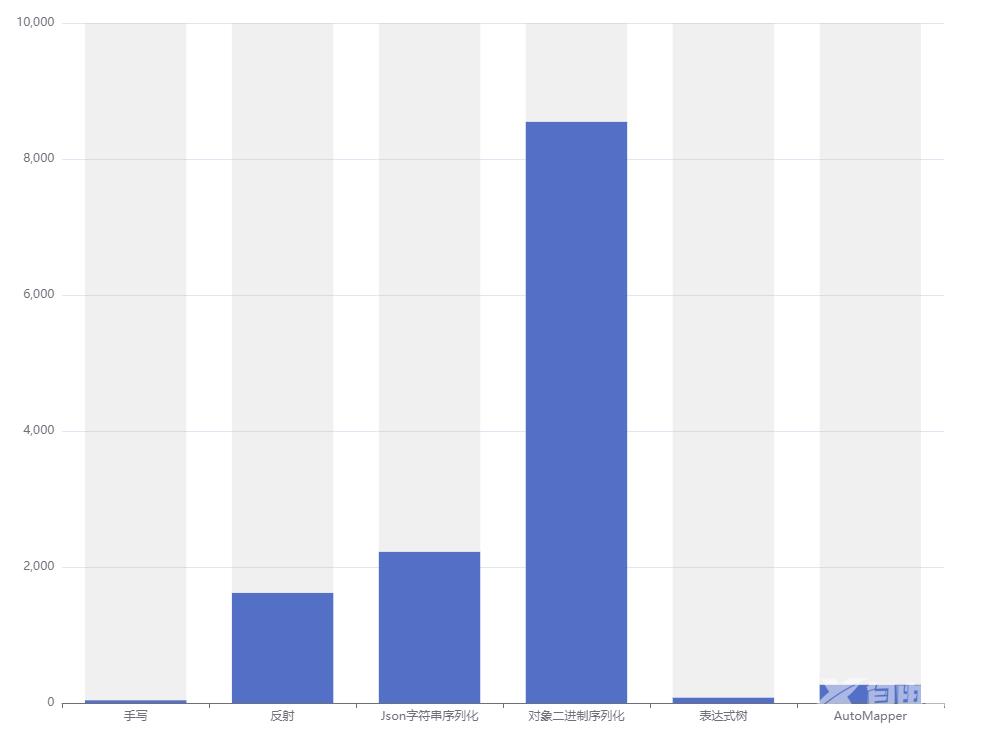目录
- 1、手写创建对象
- 2、反射
- 3、Json字符串序列化
- 4、对象二进制序列化
- 5、AutoMapper
- 6、表达式树
之前学习了设计模式原型模式,在原型模式中就提到了对象的深拷贝。深拷贝指的是拷贝一个对象时,不仅仅把对象的引用进行复制,还把该对象引用的值也一起拷贝。与浅拷贝不同的就是,深拷贝后的拷贝对象就和源对象互相独立,其中任何一个对象的改动都不会对另外一个对象造成影响。
在查询资料之后,探究了以下几种C#对象深拷贝方式,同时简单对比了以下列出的几种深拷贝方式的速度(简单测试,仅测试对象深拷贝速度,不考虑性能影响)。
测试平台:Intel 9700K+DDR4 3600 32G,框架为.NET 5.0。测试方式为创建100万次,比较执行时间。拷贝的对象如下:
[Serializable]
class UserInfo
{
public string Name { get; set; }
public string UserId { get; set; }
public int Age { get; set; }
public string Address { get; set; }
public long UpdateTime { get; set; }
public long CreateTime { get; set; }
}
1、手写创建对象
简单对象创建,不考虑有构造函数的情况。
NewUserInfo newInfo = new NewUserInfo()
{
Name = info.Name,
Age = info.Age,
UserId = info.UserId,
Address = info.Address,
UpdateTime = info.UpdateTime,
CreateTime = info.CreateTime,
};
100万次执行时间为39.4073ms,位居第一。当然,在这种不考虑构造函数的情况下,手写创建肯定是最快的。但是同时,如果遇到复杂对象,代码量也是最多的。
2、反射
这也是在日常代码中最常用的方式之一。
private static TOut TransReflection<TIn, TOut>(TIn tIn)
{
TOut tOut = Activator.CreateInstance<TOut>();
var tInType = tIn.GetType();
foreach (var itemOut in tOut.GetType().GetProperties())
{
var itemIn = tInType.GetProperty(itemOut.Name); ;
if (itemIn != null)
{
itemOut.SetValue(tOut, itemIn.GetValue(tIn));
}
}
return tOut;
}
调用
NewUserInfo newInfo = TransReflection<UserInfo, NewUserInfo>(info);
100万次执行时间为1618.4662ms,平均执行时间为0.001618,看起来还行。
3、Json字符串序列化
使用System.Text.Json作为序列化和反序列化工具。
UserInfo newInfo = JsonSerializer.Deserialize<UserInfo>(JsonSerializer.Serialize(info));
100万次执行时间为2222.2078ms,比反射慢一点点。
4、对象二进制序列化
首先不推荐使用这种方式,一是BinaryFormatter.Serialize微软已不推荐使用(据微软官网文档说是有漏洞,具体有什么漏洞没细究),二是必须在要序列化的对象上面写上Serializable的关键字,三是速度并不理想。
private static TOut ObjectMemoryConvert<TIn, TOut>(TIn tIn)
{
using (MemoryStream ms = new MemoryStream())
{
BinaryFormatter formatter = new BinaryFormatter();
formatter.Serialize(ms, tIn);
ms.Position = 0;
return (TOut)formatter.Deserialize(ms);
}
}
100万次执行时间为8545.9835ms,讲道理应该是比Json序列化要更快的,但是实际上慢了许多。
5、AutoMapper
熟悉的AutoMapper,性能也没有让我们失望。
//循环外创建MapperConfig var config = new MapperConfiguration(cfg => cfg.CreateMap<UserInfo, UserInfo>()); var mapper = config.CreateMapper(); //循环内调用 UserInfo newInfo = mapper.Map<UserInfo>(info);
100万次执行时间为267.5073ms,位居第三。
6、表达式树
重头戏来了,此处代码来源于文首中的博客中,性能让人大吃一惊。其原理是反射和表达式树相结合,先用反射获取字段然后缓存起来,再用表达式树赋值。
public static class TransExp<TIn, TOut>
{
private static readonly Func<TIn, TOut> cache = GetFunc();
private static Func<TIn, TOut> GetFunc()
{
ParameterExpression parameterExpression = Expression.Parameter(typeof(TIn), "p");
List<MemberBinding> memberBindingList = new List<MemberBinding>();
foreach (var item in typeof(TOut).GetProperties())
{
if (!item.CanWrite) continue;
MemberExpression property = Expression.Property(parameterExpression, typeof(TIn).GetProperty(item.Name));
MemberBinding memberBinding = Expression.Bind(item, property);
memberBindingList.Add(memberBinding);
}
MemberInitExpression memberInitExpression = Expression.MemberInit(Expression.New(typeof(TOut)), memberBindingList.ToArray());
Expression<Func<TIn, TOut>> lambda = Expression.Lambda<Func<TIn, TOut>>(memberInitExpression, new ParameterExpression[] { parameterExpression });
return lambda.Compile();
}
public static TOut Trans(TIn tIn)
{
return cache(tIn);
}
}
调用
UserInfo newInfo = TransExp<UserInfo, UserInfo>.Trans(info);
100万次执行时间为77.3653ms,位居第二。仅比手写慢一点点。
简单整理成柱状图,可以很清晰的对比出这几种深拷贝方式之间的速度差距。总结来说就是,一般简单的对象深拷贝,推荐直接手写,复杂对象深拷贝,推荐使用表达式树。当然,如果创建对象中还涉及到构造函数初始化,那又是不同的情况,这里暂不讨论。

附上本次测试用的完整代码。
using AutoMapper;
using System;
using System.Collections.Generic;
using System.Diagnostics;
using System.IO;
using System.Linq.Expressions;
using System.Runtime.Serialization;
using System.Runtime.Serialization.Formatters.Binary;
using System.Text.Json;
using System.Threading.Tasks;
namespace TestObjectDeepCopy
{
class Program
{
static void Main(string[] args)
{
UserInfo info = new UserInfo()
{
Name = "张三",
Age = 18,
UserId = Guid.NewGuid().ToString("N"),
Address = "银河系地球中国",
UpdateTime = 1615888888,
CreateTime = 1615895454,
};
var config = new MapperConfiguration(cfg => cfg.CreateMap<UserInfo, UserInfo>());
var mapper = config.CreateMapper();
int count = 1000000;
Stopwatch sw = new Stopwatch();
sw.Start();
for (int i = -0; i < count; i++)
{
//手写 39.4073ms
//UserInfo newInfo = new UserInfo()
//{
// Name = info.Name,
// Age = info.Age,
// UserId = info.UserId,
// Address = info.Address,
// UpdateTime = info.UpdateTime,
// CreateTime = info.CreateTime,
//};
//反射 1618.4662ms
//UserInfo newInfo = TransReflection<UserInfo, UserInfo>(info);
//Json字符串序列化 2222.2078ms
//UserInfo newInfo = JsonSerializer.Deserialize<UserInfo>(JsonSerializer.Serialize(info));
//对象二进制序列化 8545.9835ms
//UserInfo newInfo = ObjectMemoryConvert<UserInfo, UserInfo>(info);
//表达式树 77.3653ms
//UserInfo newInfo = TransExp<UserInfo, UserInfo>.Trans(info);
//AutoMapper 267.5073ms
//UserInfo newInfo = mapper.Map<UserInfo>(info);
}
Console.WriteLine("总共花费{0}ms.", sw.Elapsed.TotalMilliseconds);
sw.Stop();
Console.ReadKey();
}
private static TOut TransReflection<TIn, TOut>(TIn tIn)
{
TOut tOut = Activator.CreateInstance<TOut>();
var tInType = tIn.GetType();
foreach (var itemOut in tOut.GetType().GetProperties())
{
var itemIn = tInType.GetProperty(itemOut.Name); ;
if (itemIn != null)
{
itemOut.SetValue(tOut, itemIn.GetValue(tIn));
}
}
return tOut;
}
private static TOut ObjectMemoryConvert<TIn, TOut>(TIn tIn)
{
using (MemoryStream ms = new MemoryStream())
{
BinaryFormatter formatter = new BinaryFormatter();
formatter.Serialize(ms, tIn);
ms.Position = 0;
return (TOut)formatter.Deserialize(ms);
}
}
}
public static class TransExp<TIn, TOut>
{
private static readonly Func<TIn, TOut> cache = GetFunc();
private static Func<TIn, TOut> GetFunc()
{
ParameterExpression parameterExpression = Expression.Parameter(typeof(TIn), "p");
List<MemberBinding> memberBindingList = new List<MemberBinding>();
foreach (var item in typeof(TOut).GetProperties())
{
if (!item.CanWrite) continue;
MemberExpression property = Expression.Property(parameterExpression, typeof(TIn).GetProperty(item.Name));
MemberBinding memberBinding = Expression.Bind(item, property);
memberBindingList.Add(memberBinding);
}
MemberInitExpression memberInitExpression = Expression.MemberInit(Expression.New(typeof(TOut)), memberBindingList.ToArray());
Expression<Func<TIn, TOut>> lambda = Expression.Lambda<Func<TIn, TOut>>(memberInitExpression, new ParameterExpression[] { parameterExpression });
return lambda.Compile();
}
public static TOut Trans(TIn tIn)
{
return cache(tIn);
}
}
[Serializable]
class UserInfo
{
public string Name { get; set; }
public string UserId { get; set; }
public int Age { get; set; }
public string Address { get; set; }
public long UpdateTime { get; set; }
public long CreateTime { get; set; }
}
}
到此这篇关于C#深拷贝方法探究及性能比较的文章就介绍到这了,更多相关C#深拷贝方法内容请搜索自由互联以前的文章或继续浏览下面的相关文章希望大家以后多多支持自由互联!
